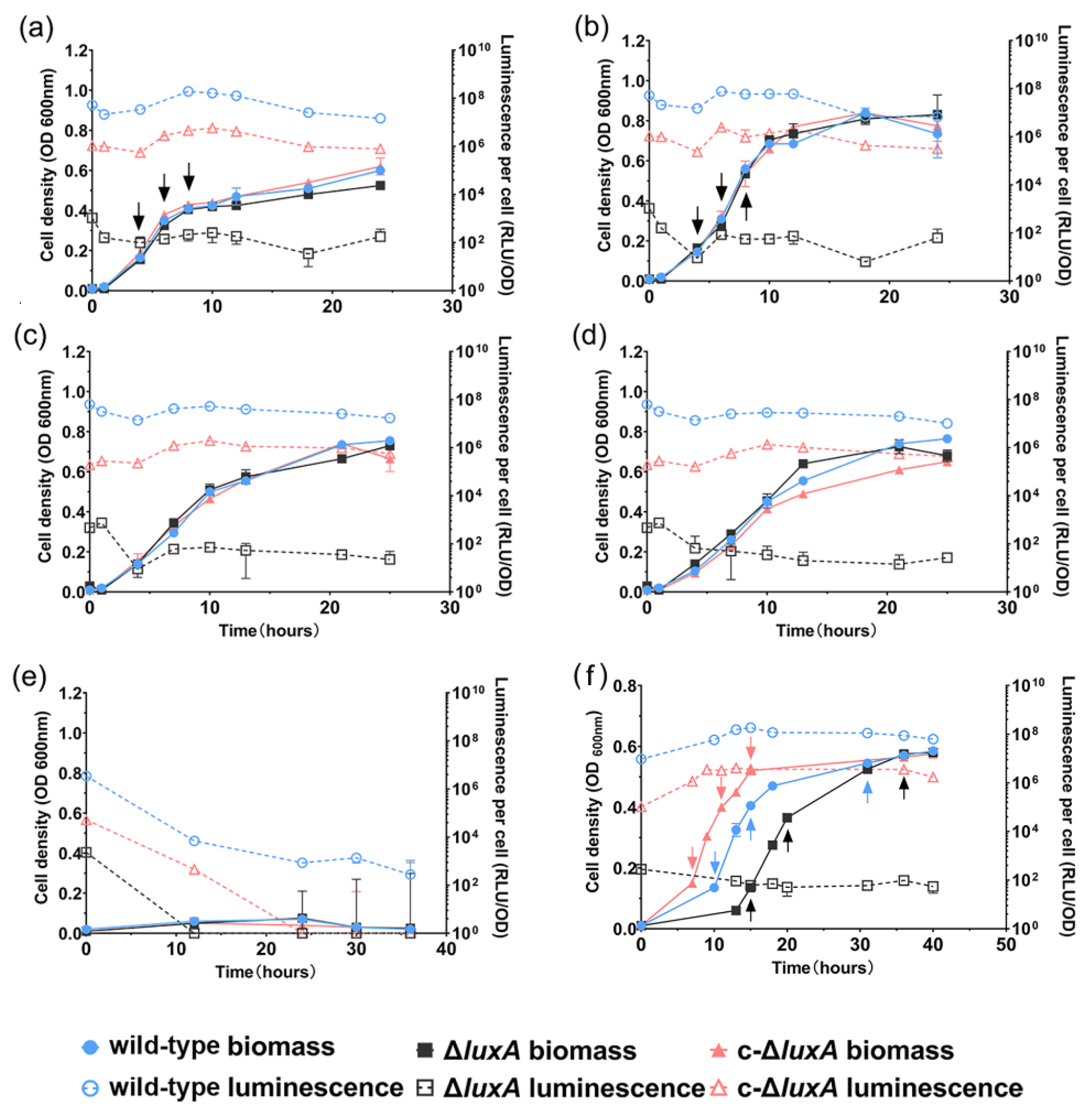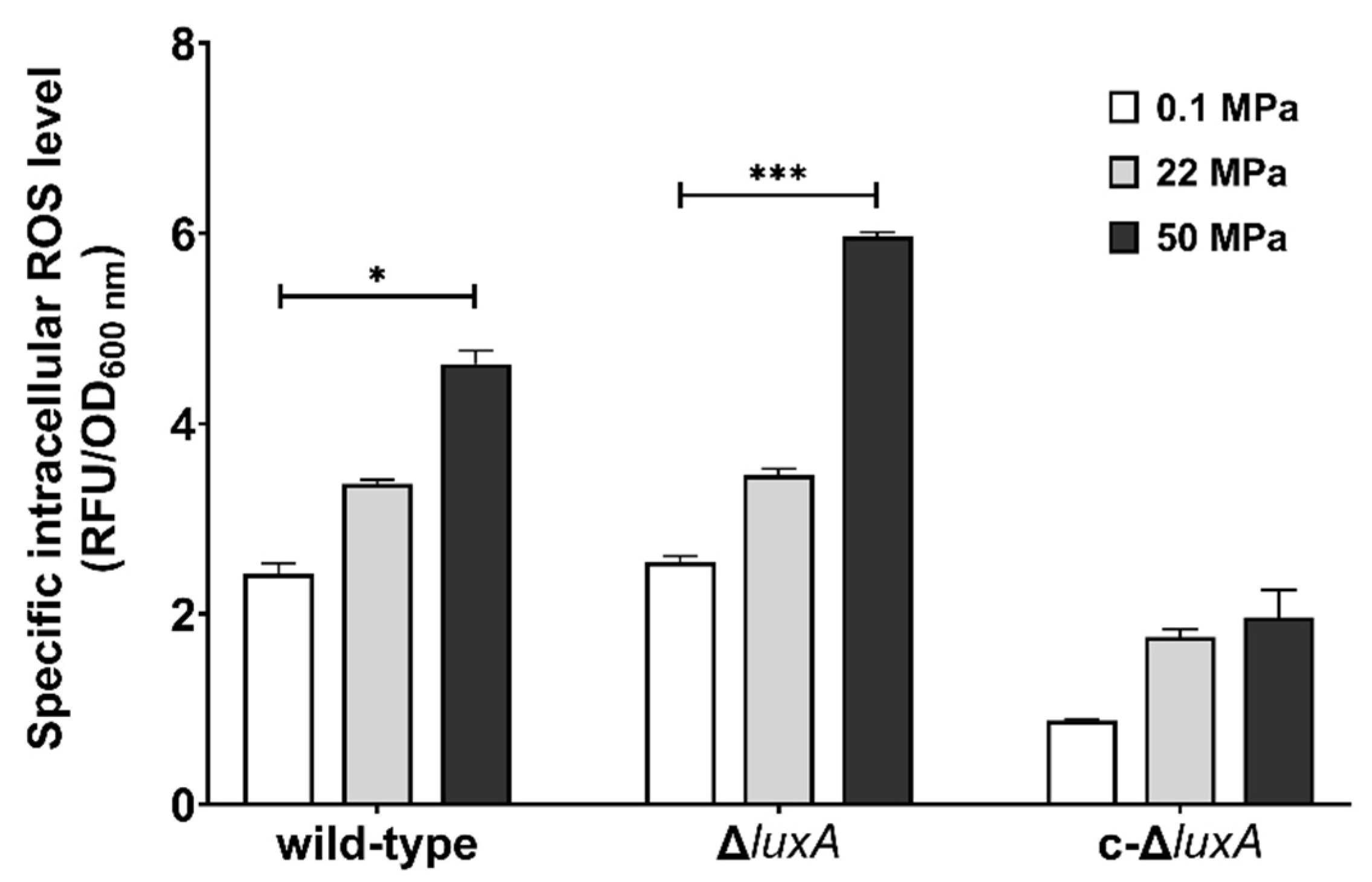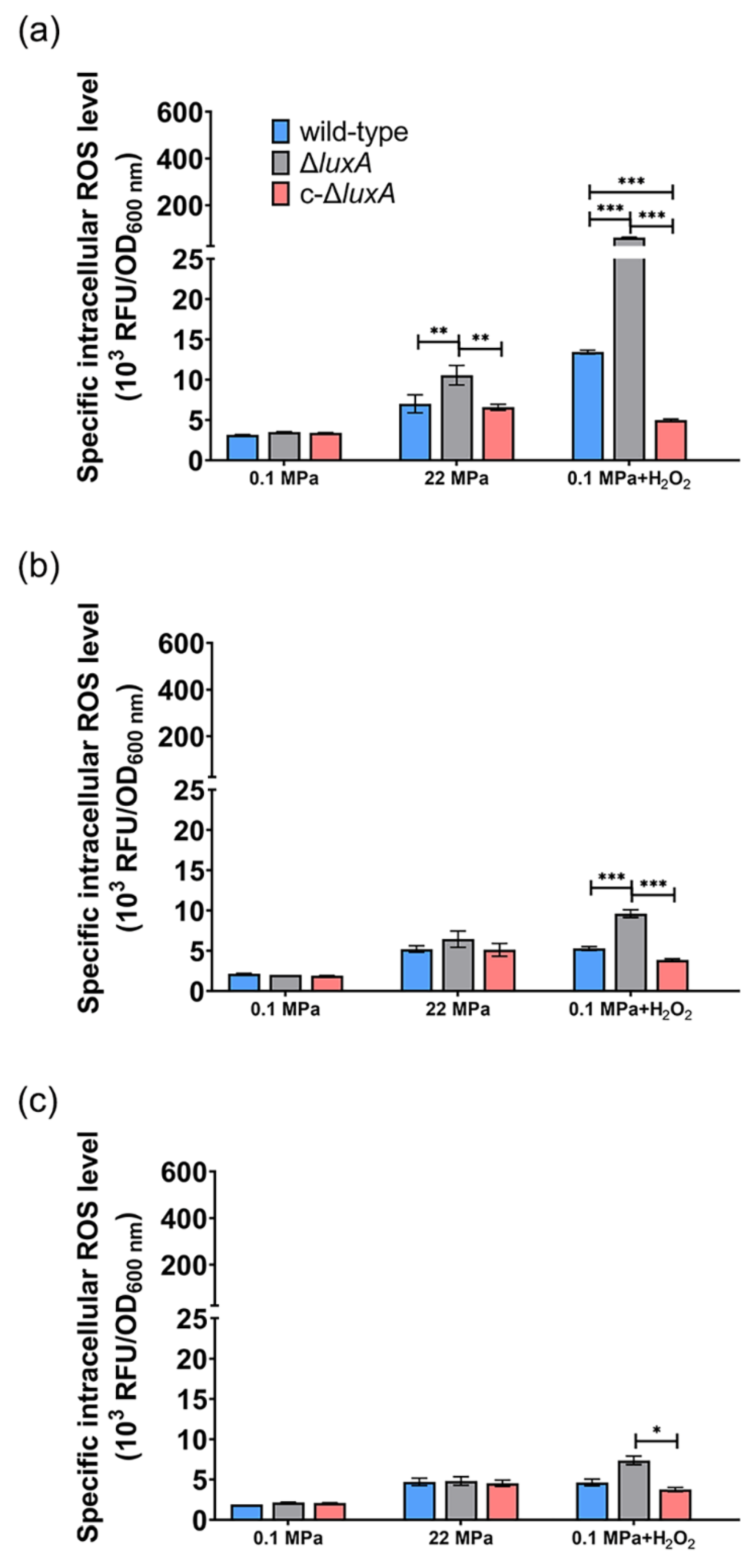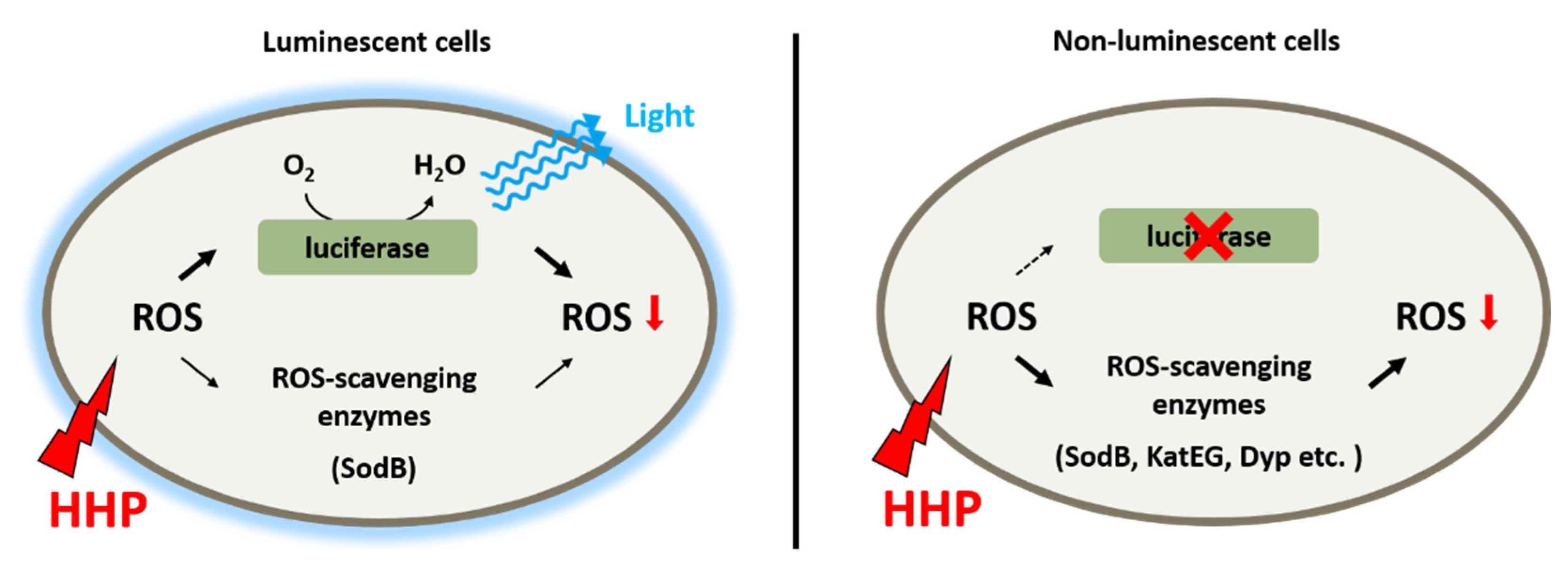Bioluminescence Contributes to the Adaptation of Deep-Sea Bacterium Photobacterium phosphoreum ANT-2200 to High Hydrostatic Pressure
Abstract
:1. Introduction
2. Materials and Methods
2.1. Bacterial Strains
2.2. Construction of luxA Mutant and Complementary Strain
2.3. Growth Experiment and Luminescence Assays
2.4. Reactive Oxygen Species (ROS) Quantification
2.5. RNA Extraction and Real-Time PCR
2.6. HHP Treatment and Growth Experiment
2.7. UV Light Irradiation Assay
3. Results
3.1. Bioluminescence Favors Bacterial Recovery from High Hydrostatic Pressure
3.2. Higher Level of ROS Is Generated by HHP in the Non-Luminescent Mutant
3.3. Alternative ROS-Scavenging Enzymes Are Induced in the Non-Luminescent Mutant in Response to HHP
3.4. Different ROS Elimination Rates in the Luminescent and Non-Luminescent Cells
4. Discussion
Supplementary Materials
Author Contributions
Funding
Institutional Review Board Statement
Informed Consent Statement
Data Availability Statement
Conflicts of Interest
References
- Tamburini, C.; Canals, M.; Durrieu de Madron, X.; Houpert, L.; Lefèvre, D.; Martini, S.; D’Ortenzio, F.; Robert, A.; Testor, P.; Aguilar, J.A.; et al. Deep-sea bioluminescence blooms after dense water formation at the ocean surface. PLoS ONE 2013, 8, e67523. [Google Scholar] [CrossRef]
- Baldwin, T.O.; Devine, J.H.; Heckel, R.C.; Lin, J.W.; Shadel, G.S. The complete nucleotide sequence of the lux regulon of Vibrio fischeri and the luxABN region of Photobacterium leiognathi and the mechanism of control of bacterial bioluminescence. J. Biolumin. Chemilumin. 1989, 4, 326–341. [Google Scholar] [CrossRef]
- Meighen, E.A. Autoinduction of light emission in different species of bioluminescent bacteria. Lumin. J. Biol. Chem. Lumin. 1999, 14, 3–9. [Google Scholar] [CrossRef]
- Makemson, J.C. Luciferase-dependent oxygen consumption by bioluminescent vibrios. J. Bacteriol. 1986, 165, 461–466. [Google Scholar] [CrossRef]
- Miyamoto, C.M.; Lin, Y.H.; Meighen, E.A. Control of bioluminescence in Vibrio fischeri by the LuxO signal response regulator. Mol. Microbiol. 2000, 36, 594–607. [Google Scholar] [CrossRef]
- Tinikul, R.; Chunthaboon, P.; Phonbuppha, J.; Paladkong, T. Bacterial luciferase: Molecular mechanisms and applications. Enzymes 2020, 47, 427–455. [Google Scholar] [CrossRef]
- Brodl, E.; Winkler, A.; Macheroux, P. Molecular Mechanisms of Bacterial Bioluminescence. Comput. Struct. Biotechnol. J. 2018, 16, 551–564. [Google Scholar] [CrossRef]
- Tanet, L.; Tamburini, C.; Baumas, C.; Garel, M.; Simon, G.; Casalot, L. Bacterial Bioluminescence: Light Emission in Photobacterium phosphoreum Is Not Under Quorum-Sensing Control. Front. Microbiol. 2019, 10, 365. [Google Scholar] [CrossRef]
- Czyz, A.; Wróbel, B.; Węgrzyn, G. Vibrio harveyi bioluminescence plays a role in stimulation of DNA repair. Microbiology 2000, 146 Pt 2, 283–288. [Google Scholar] [CrossRef]
- Kozakiewicz, J.; Gajewska, M.; Lyzeń, R.; Czyz, A.; Wegrzyn, G. Bioluminescence-mediated stimulation of photoreactivation in bacteria. FEMS Microbiol. Lett. 2005, 250, 105–110. [Google Scholar] [CrossRef]
- Czyz, A.; Plata, K.; Wegrzyn, G. Stimulation of DNA repair as an evolutionary drive for bacterial luminescence. Lumin. J. Biol. Chem. Lumin. 2003, 18, 140–144. [Google Scholar] [CrossRef] [PubMed]
- Rees, J.F.; De Wergifosse, B.; Noiset, O.; Dubuisson, M.; Janssens, B.; Thompson, E.M. The origins of marine bioluminescence: Turning oxygen defence mechanisms into deep-sea communication tools. J. Exp. Biol. 1998, 201, 1211–1221. [Google Scholar] [CrossRef]
- Timmins, G.S.; Jackson, S.K.; Swartz, H.M. The evolution of bioluminescent oxygen consumption as an ancient oxygen detoxification mechanism. J. Mol. Evol. 2001, 52, 321–332. [Google Scholar] [CrossRef] [PubMed]
- Szpilewska, H.; Czyz, A.; Wegrzyn, G. Experimental evidence for the physiological role of bacterial luciferase in the protection of cells against oxidative stress. Curr. Microbiol. 2003, 47, 379–382. [Google Scholar] [CrossRef]
- Lyzen, R.; Wegrzyn, G. Sensitivity of dark mutants of various strains of luminescent bacteria to reactive oxygen species. Arch. Microbiol. 2005, 183, 203–208. [Google Scholar] [CrossRef] [PubMed]
- Bartlett, D.H. Pressure effects on in vivo microbial processes. Biochim. Biophys. Acta 2002, 1595, 367–381. [Google Scholar] [CrossRef]
- Xiao, X.; Zhang, Y. Life in extreme environments: Approaches to study life-environment co-evolutionary strategies. Sci. China Earth Sci. 2014, 57, 869–877. [Google Scholar] [CrossRef]
- Green, J.; Paget, M.S. Bacterial redox sensors. Nat. Rev. Microbiol. 2004, 2, 954–966. [Google Scholar] [CrossRef]
- Xiao, X.; Zhang, Y.; Wang, F. Hydrostatic pressure is the universal key driver of microbial evolution in the deep ocean and beyond. Environ. Microbiol. Rep. 2021, 13, 68–72. [Google Scholar] [CrossRef]
- Wang, H.; Zhang, Y.; Bartlett, D.H.; Xiao, X. Transcriptomic Analysis Reveals Common Adaptation Mechanisms Under Different Stresses for Moderately Piezophilic Bacteria. Microb. Ecol. 2021, 81, 617–629. [Google Scholar] [CrossRef]
- Aertsen, A.; De Spiegeleer, P.; Vanoirbeek, K.; Lavilla, M.; Michiels, C.W. Induction of oxidative stress by high hydrostatic pressure in Escherichia coli. Appl. Environ. Microbiol. 2005, 71, 2226–2231. [Google Scholar] [CrossRef] [PubMed]
- Xie, Z.; Jian, H.; Jin, Z.; Xiao, X. Enhancing the Adaptability of the Deep-Sea Bacterium Shewanella piezotolerans WP3 to High Pressure and Low Temperature by Experimental Evolution under H2O2 Stress. Appl. Environ. Microbiol. 2018, 84, e02342-17. [Google Scholar] [CrossRef] [PubMed]
- Kish, A.; Griffin, P.L.; Rogers, K.L.; Fogel, M.L.; Hemley, R.J.; Steele, A. High-pressure tolerance in Halobacterium salinarum NRC-1 and other non-piezophilic prokaryotes. Extremophiles 2012, 16, 355–361. [Google Scholar] [CrossRef]
- Badr, A.A.; Garel, M.; Cuny, P.; Miquel, J.C.; Toubal, T.; Robert, A.; Tamburini, C. Luminous bacteria in the deep-sea waters near the ANTARES underwater neutrino telescope (Mediterraean Sea). Chem. Ecol. 2010, 26, 57–72. [Google Scholar] [CrossRef]
- Zhang, S.D.; Santini, C.L.; Zhang, W.J.; Barbe, V.; Mangenot, S.; Guyomar, C.; Garel, M.; Chen, H.T.; Li, X.G.; Yin, Q.J.; et al. Genomic and physiological analysis reveals versatile metabolic capacity of deep-sea Photobacterium phosphoreum ANT-2200. Extremophiles 2016, 20, 301–310. [Google Scholar] [CrossRef]
- Martini, S.; Al Ali, B.; Garel, M.; Nerini, D.; Grossi, V.; Pacton, M.; Casalot, L.; Cuny, P.; Tamburini, C. Effects of hydrostatic pressure on growth and luminescence of a moderately-piezophilic luminous bacteria Photobacterium phosphoreum ANT-2200. PLoS ONE 2013, 8, e66580. [Google Scholar] [CrossRef] [PubMed]
- Bravim, F.; Mota, M.M.; Fernandes, A.A.; Fernandes, P.M. High hydrostatic pressure leads to free radicals accumulation in yeast cells triggering oxidative stress. FEMS Yeast Res. 2016, 16, fow052. [Google Scholar] [CrossRef]
- Martínez-Gomariz, M.; Hernáez, M.L.; Gutiérrez, D.; Ximénez-Embún, P.; Préstamo, G. Proteomic analysis by two-dimensional differential gel electrophoresis (2D DIGE) of a high-pressure effect in Bacillus cereus. J. Agric. Food Chem. 2009, 57, 3543–3549. [Google Scholar] [CrossRef]
- Johnson, L.A.; Hug, L.A. Distribution of reactive oxygen species defense mechanisms across domain bacteria. Free Radic. Biol. Med. 2019, 140, 93–102. [Google Scholar] [CrossRef]
- Bolduc, J.; Koruza, K.; Luo, T.; Malo Pueyo, J.; Vo, T.N.; Ezeriņa, D.; Messens, J. Peroxiredoxins wear many hats: Factors that fashion their peroxide sensing personalities. Redox Biol. 2021, 42, 101959. [Google Scholar] [CrossRef]
- Liao, Q.; Tao, H.; Li, Y.; Xu, Y.; Wang, H.L. Evaluation of Structural Changes and Molecular Mechanism Induced by High Hydrostatic Pressure in Enterobacter sakazakii. Front. Nutr. 2021, 8, 739863. [Google Scholar] [CrossRef] [PubMed]
- Funada, C.; Tanino, N.; Fukaya, M.; Mikajiri, Y.; Nishiguchi, M.; Otake, M.; Nakasuji, H.; Kawahito, R.; Abe, F. SOD1 mutations cause hypersensitivity to high-pressure-induced oxidative stress in Saccharomyces cerevisiae. Biochim. Biophys. Acta Gen. Subj. 2022, 1866, 355–361. [Google Scholar] [CrossRef] [PubMed]
- Hao, J.Y.; Lei, Y.Q.; Shi, J.Y.; Zhao, W.B.; Gan, Z.L.; Hu, X.; Sun, A.D. Integrative Physiological and Transcriptome Analysis Reveals the Mechanism for the Repair of Sub-Lethally Injured Escherichia coli O157:H7 Induced by High Hydrostatic Pressure. Foods 2022, 11, 2377. [Google Scholar] [CrossRef] [PubMed]
- Eruslanov, E.; Kusmartsev, S. Identification of ROS using oxidized DCFDA and flow-cytometry. Methods Mol. Biol. 2010, 594, 57–72. [Google Scholar] [CrossRef]
- Sinha, R.P.; Häder, D.P. UV-induced DNA damage and repair: A review. Photochem. Photobiol. Sci. 2002, 1, 225–236. [Google Scholar] [CrossRef]
- Zavilgelsky, G.B.; Melkina, O.E.; Kotova, V.Y.; Konopleva, M.N.; Manukhov, I.V.; Pustovoit, K.S. Photoreactivating Activity of Bioluminescence: Repair of UV-damaged DNA of Escherichia coli Occurs with Assistance of lux-Genes of Marine Bacteria. Biofizika 2015, 60, 898–905. [Google Scholar] [CrossRef]
- Vezzi, A.; Campanaro, S.; D’Angelo, M.; Simonato, F.; Vitulo, N.; Lauro, F.M.; Cestaro, A.; Malacrida, G.; Simionati, B.; Cannata, N.; et al. Life at depth: Photobacterium profundum genome sequence and expression analysis. Science 2005, 307, 1459–1461. [Google Scholar] [CrossRef]






| Strain | Description | Source |
|---|---|---|
| P. phosphoreum ANT-2200 | Isolated from Mediterranean Sea at the depth of 2200 m | [24] |
| ΔluxA | Non-luminescent deficient strains that carrying an interrupted luxA | Construct in this study |
| c-ΔluxA | luxA deficient strains expressing luxCDAB from a board-host plasmid | Construct in this study |
| P. leiognathi W9 | Isolated from Mariana Trench 1821 m | Laboratory isolation |
| P. leiognathi W214 | Isolated from Mariana Trench 1821 m | Laboratory isolation |
| P. angustum QY26 | Isolated from South China Sea 500 m | Laboratory isolation |
| E. coli WM3064 | Conjugated transfer donor bacteria, diaminopimelic acid (DAP) deficient | Laboratory stock |
| Name | Locus Tag | Gene ID | Product |
|---|---|---|---|
| sodB | PPBDW_RS05155 | 29942628 | Superoxide dismutase [Fe] |
| sod1 | PPBDW_RS07830 | 29944749 | Superoxide dismutase family protein |
| sod2 | PPBDW_RS16880 | 29945935 | Superoxide dismutase family protein |
| katE | PPBDW_RS16890 | 29945933 | Catalase |
| katG | PPBDW_RS20435 | 29945712 | Catalase |
| dyp | PPBDW_RS18040 | 29945316 | Dyp-type peroxidase |
| prx | PPBDW_RS12520 | 29943376 | Peroxiredoxin C |
Disclaimer/Publisher’s Note: The statements, opinions and data contained in all publications are solely those of the individual author(s) and contributor(s) and not of MDPI and/or the editor(s). MDPI and/or the editor(s) disclaim responsibility for any injury to people or property resulting from any ideas, methods, instructions or products referred to in the content. |
© 2023 by the authors. Licensee MDPI, Basel, Switzerland. This article is an open access article distributed under the terms and conditions of the Creative Commons Attribution (CC BY) license (https://creativecommons.org/licenses/by/4.0/).
Share and Cite
Bao, X.-C.; Tang, H.-Z.; Li, X.-G.; Li, A.-Q.; Qi, X.-Q.; Li, D.-H.; Liu, S.-S.; Wu, L.-F.; Zhang, W.-J. Bioluminescence Contributes to the Adaptation of Deep-Sea Bacterium Photobacterium phosphoreum ANT-2200 to High Hydrostatic Pressure. Microorganisms 2023, 11, 1362. https://doi.org/10.3390/microorganisms11061362
Bao X-C, Tang H-Z, Li X-G, Li A-Q, Qi X-Q, Li D-H, Liu S-S, Wu L-F, Zhang W-J. Bioluminescence Contributes to the Adaptation of Deep-Sea Bacterium Photobacterium phosphoreum ANT-2200 to High Hydrostatic Pressure. Microorganisms. 2023; 11(6):1362. https://doi.org/10.3390/microorganisms11061362
Chicago/Turabian StyleBao, Xu-Chong, Hong-Zhi Tang, Xue-Gong Li, An-Qi Li, Xiao-Qing Qi, Deng-Hui Li, Shan-Shan Liu, Long-Fei Wu, and Wei-Jia Zhang. 2023. "Bioluminescence Contributes to the Adaptation of Deep-Sea Bacterium Photobacterium phosphoreum ANT-2200 to High Hydrostatic Pressure" Microorganisms 11, no. 6: 1362. https://doi.org/10.3390/microorganisms11061362





